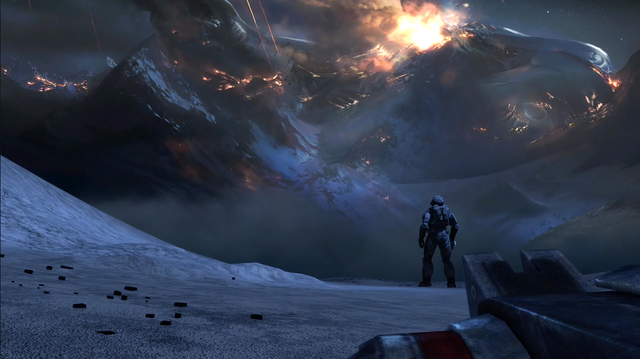TIL - Why Haven't We Created Artificial Gravity

Most sci-fi films and video games that take place on a distant planet or a space station invent some sort of mechanism for artificial gravity. That way characters like Jean-Luc Picard or Master Chief aren't floating around the place like a balloon.
Long exposure to weightlessness can have serious negative effects on human body. It weakens and degrades the muscles and bones, causes heart and vision problems and some other changes in the body. Astronauts have to be in great shape and exercise even when they are up there, on the space station. That's why having some sort of simulated gravity is not only convenient because it holds us firmly on the "ground" and oriented, but it has many health benefits as well. Tim Peake said he felt like he had the world's worst hangover after 6 months in space.
Even though it's been over fifty years since we went into space, problem of creating artificial gravity still remains. Because, as it turns out, it's a really hard and expensive endeavor. It can't just be produced from some sort of generator in a localized space.
Possible solution
Most explored and practical solution for a zero gravity problem involves centripetal force that would have the effect of pulling the subject towards the floor while it's linearly accelerating. In translation it means rotating the spaceship or a space station. Similar situation happens on one of those spinning roller coasters, where you feel weightless and your back are pulled against your sit. This concept of disc or cylinder shaped rotating object that serves as an artificial gravity generator is used in Arthur Clark's Space Odyssey, video game Halo, or TV series Babylon 5.
If we throw this spinning disc out in space, we could easily calculate it's gravity force by multiplying radius of the rotating structure with the square of it's rotational speed:
g = r * w^2
Theoretically, if we choose the radius and rotating speed of our object wisely, we could simulate Earth's 9.8 meters per second squared gravity. The smaller the rotating surface, the faster it needs to spin.
Back in 1960s NASA developed this huge centrifuge to simulate gravity. You can see that it's only the inertia carrying him forward while the centripetal force is pulling him towards the floor, preventing him from flying off.
Challenges
Being in an environment that spins so fast is not a pleasant experience as you might think. Coriolis effect (relative motion depending on the rotating reference frame) would cause physiological issues like dizziness and disorientation. Since your head is closer to the center of the disc you would feel less of the centripetal force in your head and, with it, less gravity. Condition human body is not used to.
Minimal radius of this disc that would be more or less convenient for astronauts to be in is around 100 meters, which is twice the length of International Space station.
Another big issue is cost. To send a kilogram of material into space it costs about $2700. That means the cost of the new, artificial gravity space station could be up to couple of trillion dollars.

Figuring out a way to create artificial gravity will vastly improve our experience and chances of exploring distant planets and objects like Mars. It may even be the key to developing life in space. Hopefully, it will happen soon enough.
Hope you liked this! If you do, don't forget to upvote and resteem it. Also make sure to follow @alcibiades to stay updated about future posts .

Very well written post on the difficulties of creating artificial gravity! The effect of creating the "effect" so to speak, of gravity would indeed be hard on the body as you describe. These are concepts that we don't often get to think about! Looking forward to your future content!
As a bonus, and in addition to resteeming for exposure. We are awarding you a small 5 Steem Power deposit as a thank you for creating quality STEM related postings on Steemit. We hope you will continue to educate us all!
https://steemit.chat/channel/steemSTEM
Thanks for sharing, guys! Hopefully, I'll write more STEM related posts in the future.
The reason we haven't invented artificial gravity is that we have no real idea of how gravity works.
another way to simulate gravity, which is indistinguishable from the real thing, is acceleration.
a constant acceleration of 32 ft sec^2 is indistinguishable from earth gravity.
until you run out of fuel.
That is one of the reasons.
great posting...voted...^^
Thanks, glad you liked it!
The effects of body disintegration are not due to low gravity conditions.
And the reason why we haven't developed artificial gravity is that we know next to nothing about gravity. The supposed gravitational constant was discovered by one guy, using dubious methods in a barn. The experiment has not been repeated. (as far as I know) We only assume it is because of mass.
If the flat earthers are even partially correct, we do not live on ball of solid matter. If not, then we have no clue about relationship of mass and gravity. When we do find out what shape the earth really is, then we may begin in earnest to think about gravity.
Einstein said that light was the fastest speed in the universe. Tesla argued that it was gravity. Since there are several things being show to be faster than the speed of light, and since I believe in Tesla, I believe that gravity is the upper speed of the universe. (as far as linear motion)
There are aether theories that what holds us to the ground is a continuous flow of aether downward. Since contemporary science holds aether theory as a joke, we will probably never find out, if this is actually the case.
With technology still being so young, we could argue if everything we "know" right now is true. Einstein, Tesla, Newton, Cavendish, they could all be wrong...
centripetal force was a 1950's idea of a rotating space station simulating gravity. Fact is, you need mass. Put an earth-sized moon in orbit and problem solved LOL!! Personally, I believe we should solely rely on robots and perfect their sensing abilities to give us the analogous virtual experience
Yeah, making that earth-sized rotating moon might be a little tricky :D
I like thinking that one day people could build a large space station with centripetal gravity. The center of this tube would have little gravity allowing people to fly with wings and bike powered planes.
I'm not sure if they would fly or just float around, but it's an interesting topic to think about. :) Thanks for reading!
Human body is made for 75% of water, which has quite a dipolar behavior. Maybe to use magnetic (non electro-magnetic, just magnetic) wave interaction with body water could create such a distributed force?
Hope you aren't carrying anything build with iron. Like protheses. Or a watch. Or something electronic like a smartphone or a pacemaker.
Or maybe astronauts can use it in a confined space, like sleeping only, or to recover....where is the point , exactly? Feasibility is not implementation.
One of the few SF shows to use spin gravity was Babylon 5. That station was huge, but maybe still not big enough for realism on that topic.
http://scifi.stackexchange.com/questions/109792/how-fast-did-babylon-5-spin-or-what-was-the-highest-gravity-level-on-board
It already happened in the '50s